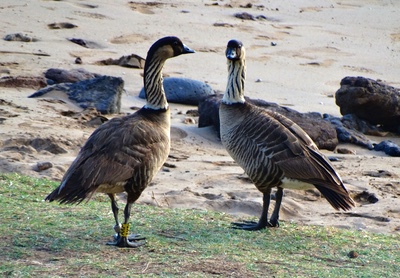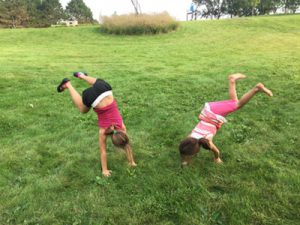
Photo by Barbara Craig
500,000 years ago some Canadian Geese got a little lost and decided to take a rest stop on the Hawaiian Islands. It was an area with plenty of food, fresh air and no predators so they decided to stay.
As the terrain of the islands was different than what they were used to the geese adapted to their new surroundings. There were few trees in Hawaii so they became ground nesters. There were few lakes to swim in, but a lot of lava to traverse, so the webbing of their feet receded and they developed three toes on each foot—more suitable for walking on jagged terrain. There was an abundance of berries on land so they no longer needed to dive underwater to find food. As a result, their necks shortened and their legs became longer.
After many generations, they were no longer Canadian. They became Nēnē, the state bird of Hawaii.
It took the Nēnē hundreds of thousands of years for their bodies to adapt to their new terrain. Their adaptations led to a thriving population—at least until humans arrived in Hawaii, which is a story for later.
Over many generations, the Canadian Geese’s adaptations resulted in their evolving into a new species. While as far as I know, humans will not evolve into a new species any time soon, some striking human adaptations are now happening in the span of one lifetime.
It used to be that almost all humans could walk barefoot for miles. We could easily squat low on the ground and stand right up again. We could comfortably sit on the ground for hours on end. We could easily see far out into the horizon and then immediately switch our gaze to inspect a baby ant. We could hang from a tree and pull ourselves up into it.
Humans are still born with the potential to do all these things but most of us have lost these abilities because we have adapted to a modern terrain—of our own creation.
As we developed cars and other vehicles we lost our ability to walk long distances. We built cement pathways so that when we do walk, it is only with a limited range of foot and ankle motion. We spend a lot of time sitting in chairs so our spines round, our muscles atrophy, and our backs ache. We spend hours staring at screens and are losing our ability to see beyond the room we are cloistered in. Since we buy our fruit at the grocery store, we don’t need to reach up into trees. Now, many of us can no longer easily lift our arms overhead.
In our quest to make things easier and more comfortable we have created an environment that has ultimately led to more discomfort, pain and disease.
In recent times, rats and mongoose brought to Hawaii by humans have rendered the Nēnē an endangered species.
Today our well-being is endangered but unlike the Nēnē, we are doing it ourselves.


